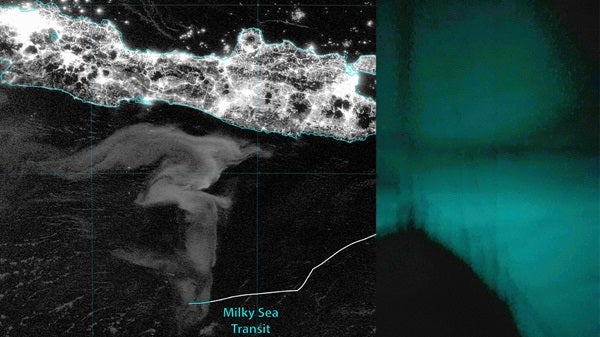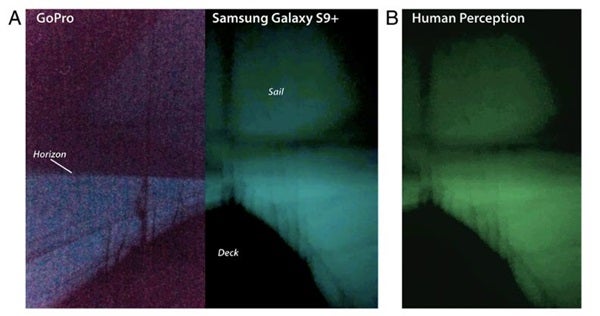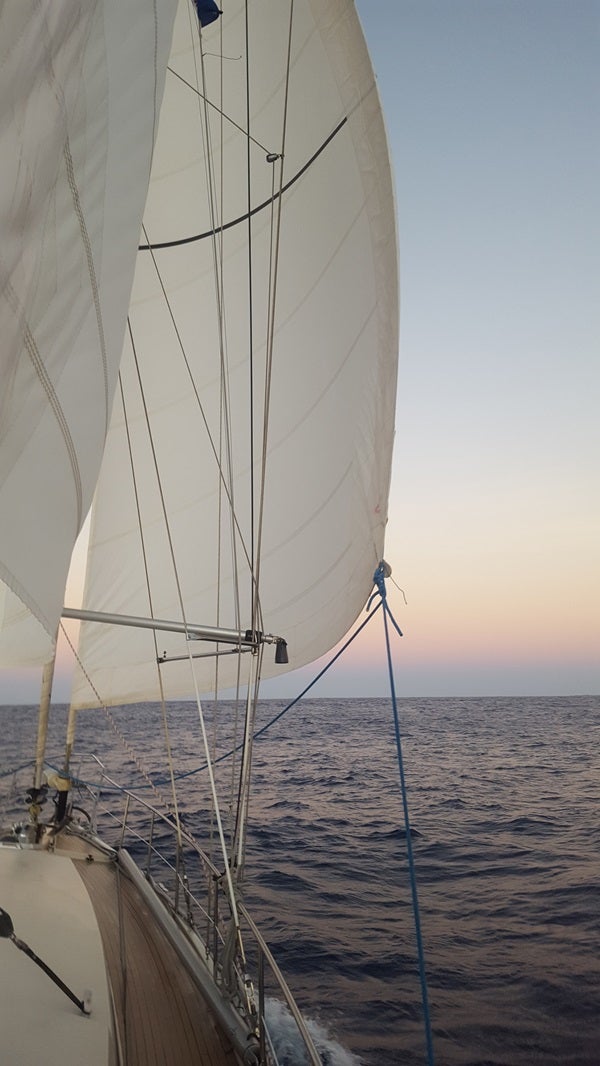For centuries, sailors have told tales of nights when, for a few surreal hours or more, their ships would come across seas that glow the color of milk. The eerie phenomenon appeared “like a plain covered with snow,” reported the captain of a U.S. clipper ship that sailed through one such “milky sea” off the coast of Java, Indonesia, July 27, 1854.
Unlike the short-lived glow of plankton that is commonly seen in the disturbed wake of a ship, milky seas can extend for tens or even hundreds of miles. They are also rare, reported just a couple of times per year, which makes them difficult for scientists to study and sample. In the past few years, a team led by Steven Miller, atmospheric scientist at Colorado State University in Fort Collins, turned to satellite images to try to identify possible cases of milky seas, and found increasing success. But they hadn’t been able to corroborate any of these potential detections with eyewitness accounts — until now.
A paper published July 11 in Proceedings of the National Academy of Sciences recounts the experiences of the crew of Ganesha, a 52-foot (16 meters) yacht that encountered a milky sea as it sailed south of Java. One of the crew, Naomi McKinnon, contacted Miller after seeing news coverage of his satellite detection of the same event.
The crew also managed to capture images with a GoPro and Samsung smartphone — perhaps the first ever eyewitness photos of milky seas. “These photos give visual testimony to the written accounts of mariners across the centuries,” writes Miller.
A chance encounter
Milky seas have long been part of nautical lore. Herman Melville included an account of one in Moby-Dick, and the Nautilus encounters one in Jules Verne’s classic 20,000 Leagues Under the Sea.
But while other sailors’ legends have become well-established in the scientific canon, like giant squid and rogue waves, “milky seas have eluded scientific inquiry,” writes Miller. Only once has a research vessel encountered a milky sea: in 1985, by chance, in the Arabian Sea. Examination of their samples of the glowing water suggested that milky seas are caused by fields of trillions of bioluminescent bacteria, communicating with each other and reaching a sort of quorum to glow in unison. Many questions about this process remain unanswered.
Around the beginning of this century, researchers began scouring satellite data to try to study milky seas. Unfortunately, identifying them in images is harder than it might sound. Their pale glow is up to 1,000 times fainter than moonlight, which can reflect off the water. Milky seas can also be easily confused with features like clouds, airglow (the soft fluorescent glow of air molecules in the upper atmosphere), and even waves of air heaving through the atmosphere. In 2005, a team of researchers led by Miller reported one milky sea in satellite data from 1995, but the data quality was too low to learn much from it. The luminous patch of ocean was identifiable only because they knew where to look, guided by a report from a British merchant vessel.
But recently, low-light satellite imaging has improved greatly thanks to a new generation of sensitive detectors launched on a pair of NOAA satellites in 2011 and 2017. Last year, Miller and his colleagues reported a dozen possible milky sea detections over eight years of data, including one in 2019 off the coast of Java that was the size of Iceland and persisted for over a month. Still, the team had no eyewitness reports to confirm any of its new candidates.
Then, McKinnon of the Ganesha contacted them.
Like generations of mariners before them, she and her fellow crewmates had been flummoxed by what they saw as they ran downwind on the waters south of Java the night of Aug. 2, 2019. An entry from Ganesha’s log reads:
When waking up at 2200 the sea was white. There is no moon, the sea is apparently full of ? plankton ? but the bow wave is black! It gives the impression of sailing on snow!
One of the crew told Miller:
Both the color and intensity of the glow was akin to glow-in-the-dark stars/stickers, or some watches that have glowing parts on the hands … a very soft glow that was gentle on the eyes.
The ship continued sailing through what the crew described as a “luminous snowfield” until dawn, roughly 8 hours after they first entered the milky sea.
From their up-close vantage point, the crew could make observations that proved intriguing to researchers. For instance, the wake off the ship’s stern did not noticeably brighten. And, in fact, the bow wave coming off the front of the ship seemed to darken the waters, not brighten it.
The ships’ captain, Johan Lemmens, also told Miller that the glow seemed to be emanating from some 30 feet (10 meters) below the surface. This contradicts one hypothesis that holds that the bacteria live and grow only on the surface of the water, like a slick of oil.
For Miller, the Ganesha’s account doesn’t just show the value of in situ observations — it also validates the approach of seeking out milky seas from orbit. “The biggest missing link in our study from last year was the lack of ground truth,” Miller said in a statement. “But this current study provides it. It was a great relief to get this contact from the Ganesha crew.”
The fact that this milky sea was so long-lived also opens the door for future expeditions: If researchers identify a milky sea via satellite early enough, a research vessel could chase one down to study it.
Alien luminescence
Earth scientists are not the only ones interested in such phenomena: Astronomers have also considered whether alien planets might have life that emits light — and whether they could detect that light with telescopes.
Possibilities include not only bioluminescent organisms, like those in milky seas that directly produce light, but also biofluorescence, in which life forms absorb dangerous, high energy photons like UV rays, reprocess them biologically, and then reemit them at longer, safer wavelengths.
“On Earth, there are some undersea coral that use biofluorescence to render the sun’s harmful ultraviolet radiation into harmless visible wavelengths, creating a beautiful radiance,” said Lisa Kaltenegger, an astronomer at Cornell University in Ithaca, New York, in a 2019 statement. “Maybe such life forms can exist on other worlds too, leaving us a telltale sign to spot them.”
Kaltenegger and fellow Cornell astronomer Jack O’Malley-James co-authored a pair of studies investigating how hard it would be to spot fluorescing organisms on exoplanets. They found that under certain circumstances, it could be possible for the next generation of ultra-large ground-based telescopes, like the Extremely Large Telescope, currently under construction in Chile.
For instance, if a planet totally covered in biofluorescent vegetation were bombarded by a UV flare from a red dwarf host star, the light emitted by the life forms could be brighter than the light the planet reflects — so much so, that it could be up to 100 times easier for a telescope to see it against the glare of its star.
“These biotic kinds of exoplanets are very good targets in our search for exoplanets, and these luminescent wonders are among our best bets for finding life on exoplanets,” said O’Malley-James.













